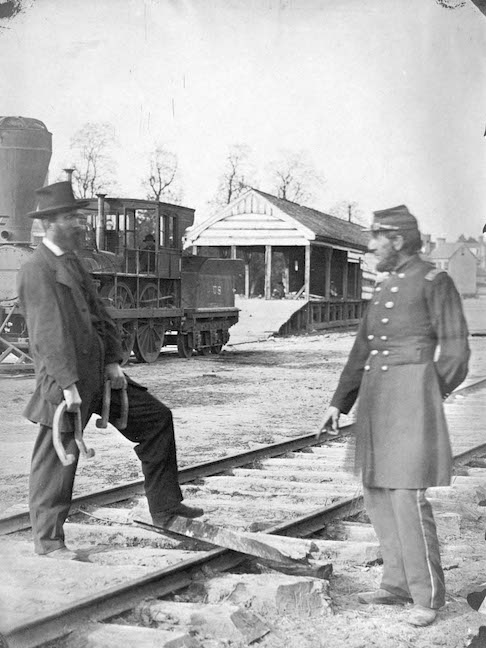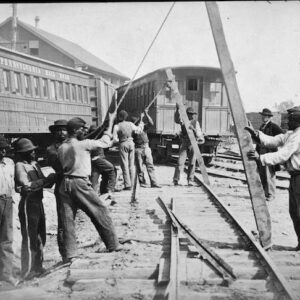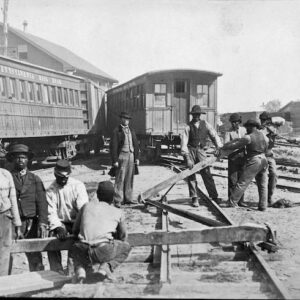| Credit: | by Russell (Andrew J.) |
|---|---|
| Date: | 1863.03-04 |
| Negative Size: | 6.5 in. x 8.5 in. |
| Equipment: | cant hook |
| Locations & Lines: | Alexandria VA; Orange & Alexandria Railroad (O&A); Virginia |
| Military Units: | US Military Railroads (USMRR); US Army |
| Persons: | Smeed (Eben C.) |
| Transports: | USMRR locomotive Lexington |
| Sources: | Huntington Library; J. Paul Getty Museum; Library of Congress |
$5.99
File Details: AADYm, 600 DPI, TIFF, Original Photograph, 17.4 Mb
Image ID: AADY
E. C. Smeed came up with the horseshoe-shaped clamps, whose use in destroying rails is demonstrated in two other photos (see Related Images). Smeed is probably the man holding the clamps in this image, taken somewhere in the USMRR compound in Alexandria, Va., with the locomotive “Lexington” in the background.
Haupt, United States Military Railway Department. Construction And Transportation. No. 49.
Haupt, Photographs Illustrative of Operations In Construction And Transportation, As Used To Facilitate The Movements Of The Armies Of The Rappahannock, Of Virginia, And Of The Potomac, Including Experiments Made To Determine The Most Practical and Expeditious Modes To Be Resorted To In The Construction, Destruction and Reconstruction Of Roads And Bridges. No. 49–The chair represents the greatest difficulty to the removal of the rail; the spikes which pass through the chairs can neither be forced back nor drawn out with implements which are effectual when applied to the intermediate spikes.
After repeated trials, the only portable contrivance which gave satisfactory results in the removal of the chair, consisted of two socket wedges of iron, with wood inserted in the back. These wedges should be 2 3/4 inches broad; they are driven under the chair, and between it and the tie, by means of axes. The time required to remove a chair from a hard firm tie, if the intermediate spikes have been forced back, is only three minutes. As the intermediate spikes can be unclasped in the same time by other hands, four men can remove a rail in three minutes, and the implements required for the purpose are two steel hooks, two wedges and two axes.
This mode of removing rails, although far superior to any known previous to the commencement of the experiments, is completely eclipsed by a simple and portable contrivance, suggested by E. C. Smeed, one of the most efficient officers of the construction corps. The contrivance consists of two pieces of iron, of the form presented in No. 49. They are placed under the two ends of the rail, as in No. 50; levers, 11 or 12 feet long and 4 1/2 or 5 inches diameter at the larger end, are inserted in the irons, when, by pulling on the levers, the whole rail is ripped from its fastenings, in less than half a minute, and the chair broken.
These irons weighed about 6 1/2 pounds: in using them fence rails will answer for levers. They not only furnish the most expeditious mode yet devised of tearing up track, but they can be used to twist the rails spirally in a cold state. To accomplish this object the levers should be applied to one end of the rail, the other end remaining in the chair; one lever having been applied and bent down to the ground, the second should be attached and a further twist given as far as the lever can be moved: then a fresh hold can be taken with the first, and the operation continued until the twist is sufficient. The rail can then be bent by pulling on a rope attacked to the loose end, and afterwards thrown out by applying one of the levers to the end had had remained fastened.
If the rail is loose, it can be twisted in the manner represented in No 51. No 49. shows a short piece of T rail that has been twisted cold by the levers, and No. 50 a short U rail, which is more difficult to twist than the T pattern.
Haupt, Reminiscences of General Herman Haupt, plate 8. Steek Hooks, and Piece of Rail Twisted by Their Use.



